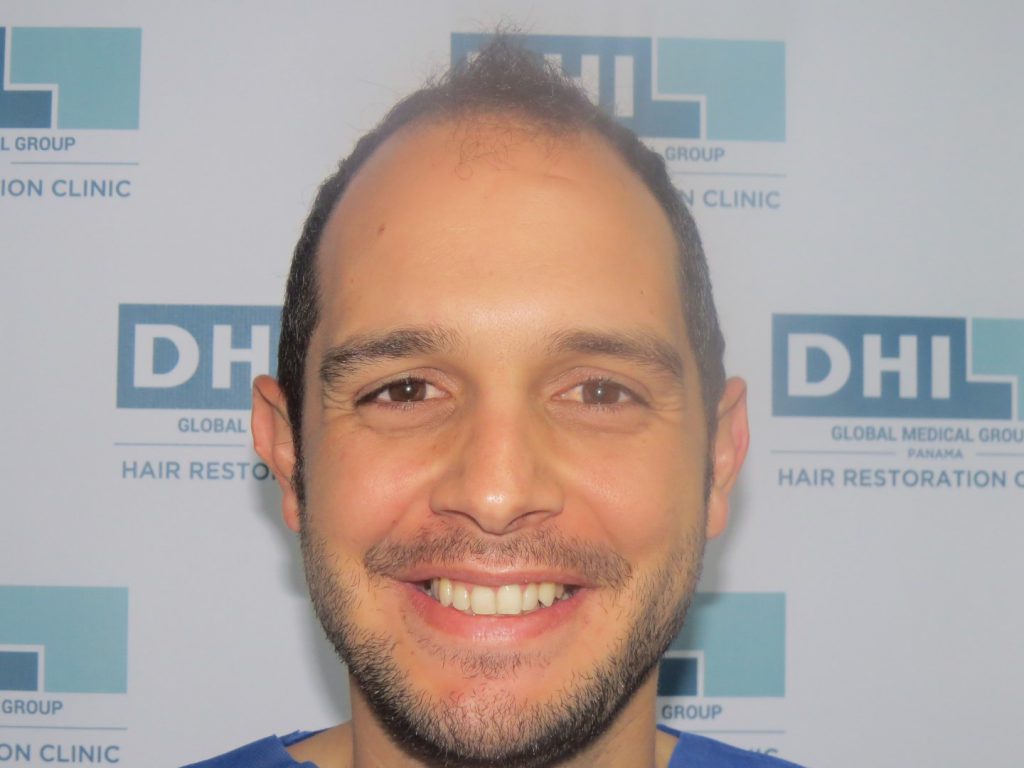Hair Loss
What are the main causes of hair loss in women?
In both women and men, the most common cause of hair loss is Androgenic Alopecia. Another may be a disease, such as Chronic Telogen Effluvium (hair is lost gradually), and women over 40 postmenopausal.
Another cause may be pregnancy, which with the massive production of the hormone estrogen causes the follicles to enter their “growth phase”. After giving birth, the hormonal balance is restored and the follicles move to the “loss phase”, causing a large amount of hair to fall all at once.
What are the main causes of hair loss in men?
The most common cause of hair loss in men is “Androgenic alopecia”, also known as “male pattern baldness”.
Androgenic alopecia is due to the hormone dihydrotestosterone (DHT) that acts on the follicles making them progressively smaller until they eventually disappear. This process is called “miniaturization”.
In addition there are factors that accelerate the process of hair loss such as stress, bacteria on the scalp, poor nutrition, hormonal imbalance, injuries and high fevers caused by diseases such as malaria, for example.
What are the types of Alopecia?
The different types of alopecia are:
- Androgenic Alopecia
- Alopecia Areata
- Alopecia by Traction
- Alopecia Cicatrizal
- Trichotillomania
- Triangular Alopecia Congenital
- Efluvio Telogeno
- Anagen Hair Syndrome
Why do women lose a lot of hair after pregnancy?
The massive production of estrogen during pregnancy is placed in its anagen “growth phase”. After birth, the hormonal balance is restored and the hair follicles enter the telogenic ‘loss phase’, causing hair loss in greater quantity.
Shaving the hair increases its thickness?
Shaving the hair does not increase the thickness or quality of the hair. At first you will see it thick, as in the roots, and the hair may look denser. But as it grows, it will look the same as before.
How do hormones affect hair loss?
The imbalance in thyroid hormones affects hair growth.
Androgens (male hormones) play the most important role in hair growth in men.
Estrogen in men decreases hair growth.
Does the survival rate of gray or black hair make any difference?
No, both gray and black hair can be transplanted and grow naturally.
About Hair
What is hair made of?
The hair is composed of keratin, a fibrous structural protein. The hair also contains natural oils (lipids) and water. These “ingredients” are arranged in 3 primary structures: the cuticle (which is the outer layer); the cortex (the interior of the hair that consists of bundles of protein filaments); and the marrow (a spongy core in the center of the cortex).
What are the hair growth cycles?
The hair growth cycle consists of 3 stages:
Anagen: The period of growth of a hair follicle that typically lasts around 3 to 5 years.
Catagen: At the end of the growth period, the follicles are prepared for the resting phase. This stage of the hair growth cycle usually lasts 1 to 2 weeks.
Telogen: This is the resting period of the follicle. It is usually 3 to 4 months long. At the end of this period many hairs will end their life cycle and fall. Letting the new hair begin to grow.
What is the rate of hair growth during each cycle?
The percentage of hair growth in each cycle is:
Telogen: 10 – 15%
Anagen: 85-90%
Catagen: <1%
How much does the hair grow?
On average, human hair grows 1/30 mm per day, 1 to 1.5 cm per month and 10-15 cm per year.
How is the quality of the hair and the growth rate in each person?
The rate of hair quality and growth depends largely on ethnicity:
- African hair grows more slowly and is more fragile than European hair.
- Asian hair grows faster and has greater elasticity.
- Africans and Europeans are more prone to baldness than Asian people.
How strong is the hair?
The hair is strong like an iron wire. It breaks after applying a force equivalent to 60 kg, only after it is stretched around 70%. A single filament can support 100 grams of weight.
What should be the diameter of healthy hair?
The average diameter of a healthy hair is 40-120 microns (1 micron = millionth of a meter).
How many hairs do we lose per day?
On average we stripped 100 to 120 hairs per day.
Why do we have different hair colors?
The hair color is due to the pigmentation of the hair follicles by two types of melanin:
- Eumelanin – pigment that gives Black or Brown color.
- Pheomelanin – pigment that gives red color to hair.
What is the hair production rate of the human being?
The hair shaft increases 0.35 mm / day and approximately 1 cm per month.
How many hairs can grow in each follicle?
For each follicle, thousands of hair can grow for life. On average, it can be said that for each one you can grow up to twenty times.
What is fine hair or fluff?
Fine hair, or also known as hair “fluff” in the urban dictionary, are thin, short, lightly colored or translucent hairs that develop from childhood and are found anywhere on the body. Its growth is not affected by hormones. These usually do not have a size greater than 2 mm, and their follicles are not associated with the sebaceous glands.
The DHI (direct hair implant) procedure
Why DHI is the best Hair Restoration Clinic?
In 2002, DHI Global Medical Group introduced to the world of hair transplantation the procedure known today as Follicular Unit Extraction (FUE), which left at that time obsolete the FUT (Follicular Unit Transplantation) or better known as the Strip. Then in 2008, develop the evolution of FUE; DHI Direct Hair Implantation.
In our first years, it took a doctor about 10 hours to extract 500 follicles and 1000 hairs. This is proof of the dedication that our organization had in the past and has today. Our mission is to offer our customers the best existing treatment.
Due to our dedication and commitment, the teaching efforts of the DHI Academy and our advanced patented technology, we have made important advances in hair restoration. Now we are able to extract and place 4,000 hairs in 7 hours and 6,000 in a two-day session.
The increase of the quality of our work, and the sustainable growth of the company worldwide, is due in part to the fact that we use our own patented instruments, and to the effort that we dedicate to the DHI Academy and its strict educational protocols.
Our medical and administrative team is the largest and most experienced in the world. We have trained more than 150 medical specialists. Now we can practice our techniques all over the world. DHI Global Medical Group is present in 36 countries.
How long does a DHI consultation take?
The consultation process involves: (1) Doing an alopecia test to evaluate hair quality. (2) Do a mathematical calculation to determine the number of hair that can be extracted and implanted. (3) Discuss the design of the hairline and its distribution, to give it a natural result and with the best possible density. All this lasts 45 minutes.
Does the DHI technique cause any pain?
The procedure is performed under local anesthesia so that the patient can relax, listen to music, watch TV, enjoy a light lunch and even nap during the procedure.
Does the hair removed from the donor area grow back?
As we extract the follicles or root, the hair does not grow back. But it has been noticed that in 5% of the cases the hair grows back because part of the root stays inside.
What precautions should be taken before and after the procedure?
Precautions to take before and after the session:
One week before the procedure, the client needs to stop consuming vitamins, aspirin, alcohol, tobacco or illicit substances. Patients suffering from diabetes, hypertension, heart problems, or if they take psychiatric medications, should be given special advice by the Physician.
After the Procedure avoid any heavy exercise such as lifting weights or swimming. Only after 3 days of the procedure can the patient resume light exercises, such as walking.
Also avoid exposing the scalp to the sun for 7 days after the procedure.
Is the procedure performed under local anesthesia?
Each DHI session is performed under local anesthesia. Anesthesia is injected into the donor area first during the extraction and then into the recipient area at the time of follicle implantation.
Is any medication prescribed after implantation?
A prescription of medications and anti-inflammatories is made for the 4 days post procedure.
How long does it take the donor area to heal?
The average healing period is 3 to 5 days.
When will the patient see complete results of his procedure?
The final result can be seen 12 months after the procedure that the hair has grown and matured. But hair growth is visible from the first month. It should be noted that as in a natural cycle of the hair, it will fall off and will grow back 4 to 5 months after the procedure.
Is it advisable to have hair strengthening treatments after implantation?
Yes, medical treatment must continue to preserve and delay the process of existing hair baldness.
Does any other clinic use the DHI direct hair implant technique?
No, currently the doctors and clinics of the region practice the FUT Technique or the FUE Technique. Direct Hair Implantation is an advanced technique that can only be performed by specialists certified by the Hair Restoration Academy of DHI.
What benefits does Platelets Rich PRP have?
Platelet Rich Plasma – PRP can be implemented in the early stages of alopecia, to delay or slow down your fall process. We also recommend it after the DHI implant, to stimulate the growth of implanted hair and delay the fall of others. These treatments should be preceded by professional advice and always accompanied in their regular use with Minoxidil and Finasteride in the case of being prescribed by the doctor.




